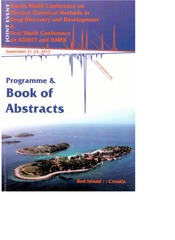| dc.creator | Filipović, Nenad | |
| dc.creator | Ninić, Jana | |
| dc.creator | Filipič, Metka | |
| dc.creator | Filipović, Miloš | |
| dc.creator | Stevanović, Magdalena | |
| dc.date.accessioned | 2017-06-10T15:45:07Z | |
| dc.date.issued | 2015 | |
| dc.identifier.uri | https://dais.sanu.ac.rs/123456789/858 | |
| dc.description.abstract | The broad spectrum of selenium applications in pharmacy and medicine has been known for a while and strongly depends on its chemical form, size and shape. However, the use of Se often requires consumption over the long period, so the toxicity of Se is always a crucial concern. Majority of available pharmaceutical products contain organic forms of selenium or its salts, but recently, when it comes to cancer treatment, elemental selenium nanoparticles (SeNPs) have emerged as a novel selenium source with the advantage of reduced risk of selenium toxicity, but with same bioavailability and efficacy in increasing the activities of selenoenzimes.
In this work we are presenting the fast, reproducible method for producing stable colloidal suspension of amorphous SeNPs (<80 nm). These SeNPS were successful incorporated within PCL microspheres by combining the high speed homogenization and the precipitation in a solvent/non-solvent system. The obtained PCL/SeNPs were characterized by Fourier transform infrared spectroscopy (FTIR), electron microscopy (SEM and TEM), X-ray diffraction (XRD) and thermal analysis methods (TGA-DTA). The cytotoxicity and the formation of intracellular reactive oxygen species of SeNPs as well as of PCL/SeNPs were investigated employing 3-(4,5-dimethylthiazol-2-yl)-2,5-diphenyltetrazolium bromide (MTT) assay and using a fluorescent probe (DCFDA test) respectively. Both systems have shown good biocompatibility. The anticancer activity of SeNPs was examined on the HeLa cell line and it was demonstrated that SeNPs exhibits strong, a dose dependent, anticancer activity by preventing further HeLa cells growth and division. Bearing in mind that PCL is well known biodegradable polymer with low degradation rate, it is our opinion that PCL/SeNPs possess a great potential for cancer treatment. | en |
| dc.format | (2015) - | |
| dc.format | application/pdf | |
| dc.language | en | |
| dc.publisher | Rovinj : International Association of Physical Chemists | |
| dc.relation | info:eu-repo/grantAgreement/MESTD/Integrated and Interdisciplinary Research (IIR or III)/45004/RS// | |
| dc.rights | openAccess | |
| dc.rights.uri | https://creativecommons.org/licenses/by-nc-nd/4.0/ | |
| dc.source | Joint Event 4th World Conference on Physico-Chemical Methods in Drug Discovery and Development (PCMDDD-4) and 1st World Conference on ADMET and DMPK | en |
| dc.subject | selenium | |
| dc.subject | nanoparticles | |
| dc.subject | cancer treatment | |
| dc.title | Selenium nanoparticles as a potential candidate in cancer treatment | en |
| dc.type | conferenceObject | |
| dc.rights.license | BY-NC-ND | |
| dcterms.abstract | Нинић, Јана; Филиповић, Милош; Филипич, Метка; Стевановић, Магдалена; Филиповић, Ненад; | |
| dc.type.version | publishedVersion | |
| dc.identifier.fulltext | https://dais.sanu.ac.rs/bitstream/id/21816/855.pdf | |
| dc.identifier.rcub | https://hdl.handle.net/21.15107/rcub_dais_858 | |

